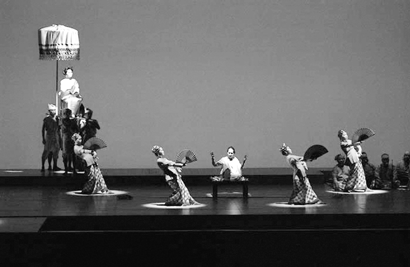Asia Society film celebrates once-revered sect; Lincoln Center performance in July
“When Ancik was a little boy, he was always interested in wearing dresses. We would hide them, but he would find them and put them on,” says a moist-eyed mother, sitting in her fishing hut on a remote speck of an island near Sulawesi, Indonesia, as her young, beautiful son is led away to start his new life as a transvestite Bissu priest. Puang Matoa Saidi, high priest of an ancient sect, has recruited Ancik to help replenish the dying ranks of this ancient order.
The adage is that “if there are five transvestites in a village, one of them is destined to become a Bissu.”
As Saidi approaches him, the shy Ancik cringes, uncertain of the world beyond his island’s dock, yet excited about the prospect of realizing his true nature as a transgendered person. As a priest, he will wear ornate attire, dance in trance ceremonies and lead a life far removed from his tiny fishing village.
Shown at the Asia Society on June 17, “The Last Bissu” is a beautiful film by Rhoda Grauer that is part of a series of events celebrating vanishing cultures and the efforts to revive them. It follows the story of Puang Matoa Saidi, the high priest of an ancient transvestite order chosen in 1941. Once all powerful, the leaders of this pre-Islamic sect were honored advisors to the local rajas, the kings who ruled the land. Their gradual demise began as the system of royal courts declined.
Later, the Bissus were nearly annihilated by government forces intolerant of unorthodox religious beliefs and transvestite behavior. Once numbered in the hundreds, the sect itself seems close to extinction with the Arajang, the sacred relic house, near dilapidation and by the end of the 20th century a mere handful of adherents in hiding, fearing for their lives.
Saidi embarks on his divine mission to revive the Bissu, who trace their origins to “I La Galigo,” an epic myth of Sulawesi’s Bugis people where gods in the heavens and the underworld struggle with human characters to find their place in the world. Saidi’s tireless appeals for support resonate especially with community elders who warmly recall the comforting Bissu practices.
Before long, sufficient funds are raised to rebuild the Arajang, giving the Scared Plow a beautiful new shrine where it can be safeguarded. Old customs come alive when the plow is anointed with unguents and taken to the rice fields for a pre-sowing benediction. Ancik’s recruitment seems a harbinger of the Bissu sect’s revival. Other transvestite boys will be found in other villages and the ranks will swell again.
Quaint and unusual to Western eyes, the transvestite priest tradition is found in numerous traditional societies in India, Burma, Indonesia and other developing nations. More than simply an anachronism, the tradition has conferred legitimacy on gender-variant individuals whose social status might otherwise be compromised were it not for the sacred roles they play.
The screening of the “The Last Bissu” was the precursor to a series of “I La Galigo” performances, conceived by Robert Wilson, at Lincoln Center’s New York State Theater in July. Fifty-three Indonesian performers, including Puang Matoa Saidi, skillfully translate the epic myths for the stage through chanted story-telling, traditional music, martial arts and dance. Coinciding with the Lincoln Center festival, the Asia Society will hold an all-day symposium on “I La Galigo” consisting of lectures, panel discussions, film and performance demonstrations on July 14.
For details, contact the Asia Society Box Office at 212-517-ASIA. For tickets to the Lincoln Center performances of “I La Galigo,” call 212- 721-6500 or visit lincolncenter.org.
gaycitynews.com


































